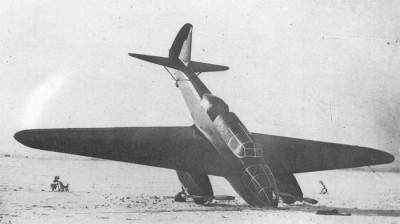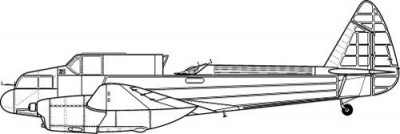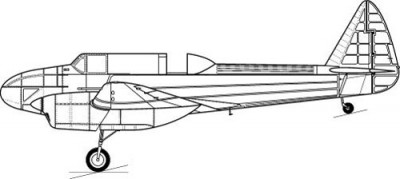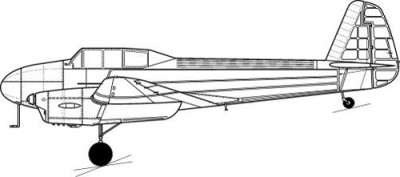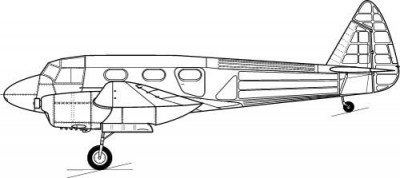Yakovlev UT-3[/heading]
In the mid-30. years, many countries began to appear specialized twin engine trainer bombers. In Germany it was Focke-Wulf Fw 58 B Weihe, in France Potez 56, the Uk Airspeed Oxford, and more. Because the soviet air force also modernising it and passed on the twin engine types, as was Tupolev SB, in 1937 the Soviet of people's commissars decided on the need to develop a machine similar category, with the model just in that Weihe. The projects developed several less busy design office - Rafaeljanc modified their traffic the RAF-11, Gribovskij suggested G-27 and Yakovlev its first twin-engine type, AIR-17. Because at that time already was the people's commissar Alexei Ivanovich Rykov, from which the abbreviation of AIR derived, arrested, Yakovlev name soon changed to the I-17 and finally to the unassailable Samoljot no. 17, abbreviated as S-17.
S-17 was a single biplane of mixed construction, with the wings forming one entity, with two beams of rectangular cross-section, framed with wooden ribs and a plywood surface. Wings was covered with canvas, from them up to the trunk then to the lower side of the wing continued to dural delamination of the flap. The hull was then welded from the pipes reinforced wires, the front part was covered with duralovým sheet and the back cloth. The Pilot sat above the wing, behind him in a separate space gunner/radio operator, and in the glassed-in bow of the navigator, or instructor, who had available a second procedure. In the lower part of the bow then was the bomb sight. Between the pilot and radistou was placed a small bomb bay with space for six 50kg or three 100kg bombs, and a radio operator with the navigator operated the movable machine guns ŠKAS. The prototype was powered by French motors Renault 6Q-01 Bengali on the performance of 220 hp. You were chosen because of their license version of the MV-6 just coming into production. The propellers were also French, dvoulisté adjustable type Ratier 1363. Tanks, each with a volume of 310 liters, were placed in the wing roots. Landing gear was retractable into the engine nacelles, and the tail wheel fixed.
S-17 began a state exam 16. may 1938. Test pilots the aircraft, in principle, have praised, with only a few suggestions for adjustments, inter alia, that the wings had detachable outer panels due to ease of transport and repair. OKB race no 115 was tasked with their implementation and also preparation of mass production. 26. August 1938, the prototype was handed over to the NII VVS for the second round of tests. In that time, has already received the official designation of the UT-3. After adjustments had reinforced the tail surfaces, electro-hydraulic control system of the chassis and flaps, and also got a solid wood propeller. It was improved cooling of the engine, and the wheels were pneumatic disk brakes. In the new form it was S-17 considered suitable for conversion training of crews of fast bombers and it was ordered the production of the series in tušinském factory no. 81.
The first series of ten machines should be in Tušinu built to 1. September 1939, but due to various problems with the preparation of the was the first of them completed only 4. September. Some of the parts for it were made in factory no. 115 and had already the engines of the MV-6 and controllable-pitch propellers AV-3. That time was also built a few other hulls and parts for other machines, but the race no 81 did not have an opportunity to finish. In the meantime, got the production drawings also race no 301 in Chimkách, another suburb of Moscow, and in August it was decided that all production should be moved there. Race no 301 was appropriate, the construction of machines of the race no 81 build two of the series after five machines. The first machine, with the serial number 301101 (race 301, 1. series, 1. machine), was completed 1. September, three days before the only machine finished the race no 81. In December 1939 was handed over to the NII VVS, but proved to be substantially heavier than the prototype, and especially the center of gravity was too far back, which meant a significantly worse stability and maneuverability. Test pilot Pyotr M. Stěfanovskij said UT-3 to be inappropriate for mass production and for the role of a practice airplane.
In Chimkách after the flight tests, no 301101 decided to finish the rest of the machine as a two-digit and unarmed. Only in the configuration for pilot training, without a gunner, his machine gun and with an empty pumovnicí, had flight characteristics similar to the prototype. Nine two-seat UT-3 was handed over to the army air corps for service tests, which were carried out between 15. may and 15. August 1940. Tests have revealed various structural and production issues and led to several accidents. UT-3 in this similarly, therefore, the tests failed and it was decided to terminate its further production in the Chimkách, where they instead started focusing on the production of Yaks 1.
Still, however, did not mean for UT-3 final end, because at the beginning of the year 1940 on the construction of the UT-3 began to get ready one more factory. In leningrad race no 47 took the unfinished components of the Chimek and Yakovlev, at that time deputy people's commissar for the aviation industry, to Leningrad as the chief engineer sent one of his collaborators Is. G. Adler - despite the fact that in the plant no 47 no chief engineer should, G. Also. Bakšajeva. In Leningrad tried to solve the problems, which revealed the date of the test. Their version of the UT-3 was a two-seater, with the dorsal area covered and simplified the bow, with a glass ceiling and without the typical crimp The leningrad UT-3 was without equipment and without radio. The first of the local UT-3, serial number 01147 (1. series, 1. machine, race 47) has been completed 26. July 1940. Commissariat of the aviation industry decided to build the UT-3 in Leningrad also support the moving of funds and personnel Bakšajevovy OKB, which meant interrupting work on his own projects, e.g. fighter with variable wings RK-. Bakšajeva and his people of course not happy about, and Bakšajev was a great critic of the UT-3, which he considered to be fundamentally flawed design, suitable for the manufacture of unless for drastic adjustments. This is also why production in Leningrad dragged on and to November 1940 was completed only eight machines.
In the meantime, under the leadership of Yevgeny Adler continued to work on improvements UT-3. His -17A, or "the standard machine for the year of 1941", was purely a training two-seater machine with a student and instructor in the joint cabin, with the pupil slightly to the left in the front and the instructor slightly to the right to have a free field of view. The bow remained empty and lacked glazing. The chassis was now hard, the hydraulic system was removed and the flaps were now pneumatic. The wings got the angle of attack of 3°. Engines were now the MV-6A with improved cooling of the cylinder, a larger oil cooler and launched by the patron. It was also about 150 mm extended motor bed. State tests and NII were held in April and may 1941, and showed a significant improvement in the longitudinal stability and, despite the fixed landing higher speed. Government testing has passed successfully and was recommended for serial production under the designation of UT-3 2MV-6A, Adler him in his memoirs he gave the name of UT-3M. Prospects finally began to look promising, but the beginning of the war again changed everything. Plus, she was terminated the production of engines of the MV-6 and radial MG-31, which were considered as their replacement. Still, the project of "the model of the machine no. 2", which was supposed to have double the tail area and the outer panels of the wings slightly tapered backward, but remained on paper only. Yakovlev UT-3 was finally dead.
Gordon, Y.; Komissarov, D.; Komissarov, With. OKB Yakovlev: a History of the Design Bureau and its Aircraft. Midland Publishing, Hinckley 2005. ISBN 1-85780-203-9.
Gunston, Bill; Gordon, Yefim. Yakovlev Aircraft since 1924. Putnam Aeronautical Books, London 1997. ISBN 0-85177-872-0.
Andersson, Lennart. Soviet Aircraft and Aviation 1917-1941. Putnam Aeronautical Books, London 1997. ISBN 0-85177-859-3.
Якубович, Николай. Як-2/Як-4 л другие ближние бомбардировщики Яковлева. Эксмо, Москва 2015. ISBN 978-5-699-83372-6.
Котельников, В. П.; Засыпкин, Ю. В. Неизвестный Утенок, Авиация и Время 1997/05-06.
Balous, Miroslav. Yakovlev S-17/UT-3, L+K 2002/07.
.
Gunston, Bill; Gordon, Yefim. Yakovlev Aircraft since 1924. Putnam Aeronautical Books, London 1997. ISBN 0-85177-872-0.
Andersson, Lennart. Soviet Aircraft and Aviation 1917-1941. Putnam Aeronautical Books, London 1997. ISBN 0-85177-859-3.
Якубович, Николай. Як-2/Як-4 л другие ближние бомбардировщики Яковлева. Эксмо, Москва 2015. ISBN 978-5-699-83372-6.
Котельников, В. П.; Засыпкин, Ю. В. Неизвестный Утенок, Авиация и Время 1997/05-06.
Balous, Miroslav. Yakovlev S-17/UT-3, L+K 2002/07.
